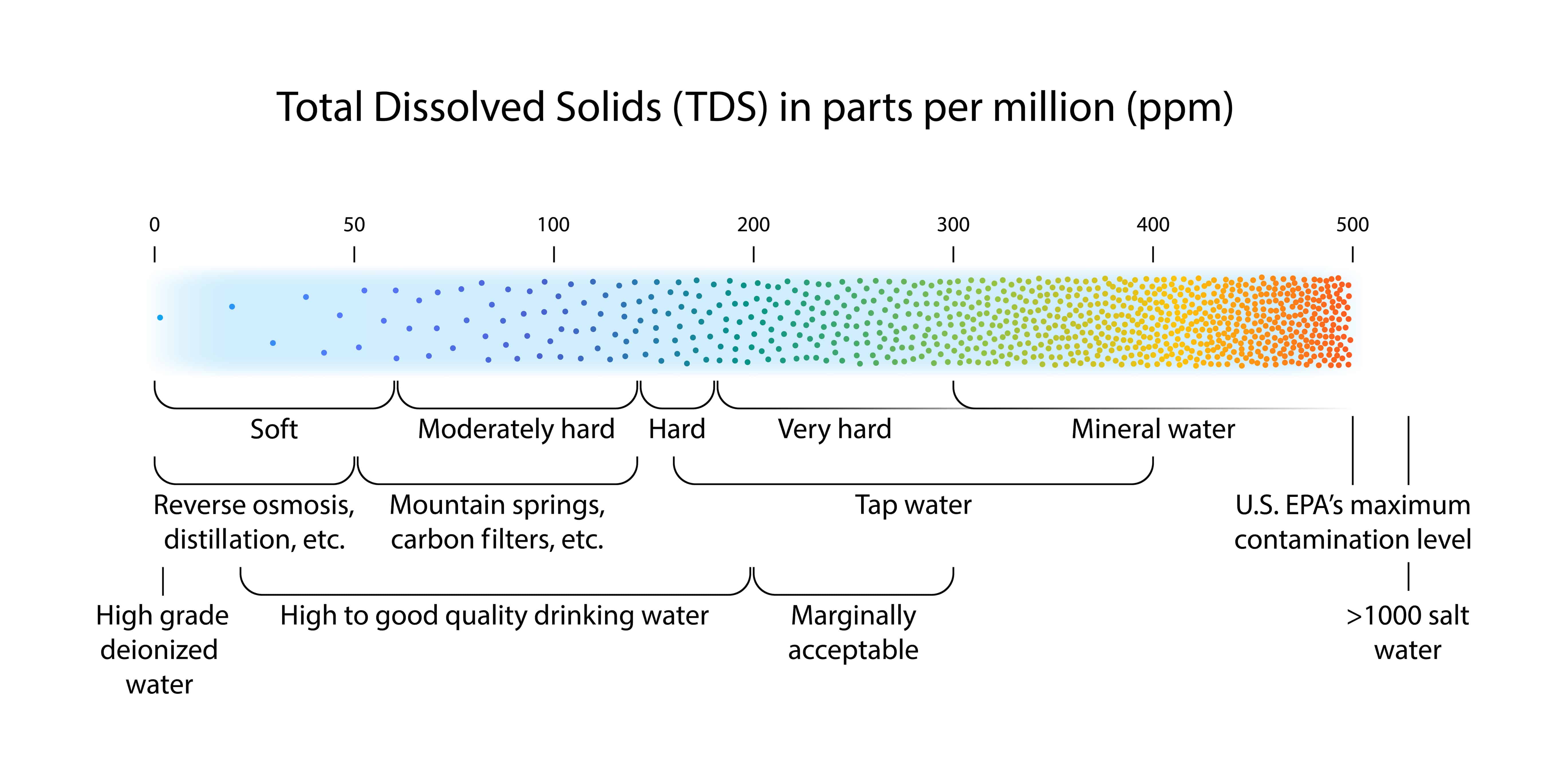Total dissolved solids (TDS) in saltwater pools refer to the amount of dissolved minerals and salts present in the water. These dissolved solids can include various minerals such as calcium, magnesium, potassium, and sodium as well as bodily fluids and personal hygiene products.
The ideal TDS level in your saltwater pool is less than 6,000 ppm. The higher your TDS level in your pool, the more likely you will experience:
- Cloudy water that isn’t crystal clear.
- Reduce effectiveness of chlorine in the water.
- An increased chance of algae.
By comparison, a regularly chlorinated pool shouldn’t have a TDS higher than 2,000 ppm. The maximum TDS in drinking water for another comparison is 500 ppm.
Why is the TDS level much higher in a saltwater pool?
In a saltwater pool, TDS levels are primarily influenced by the salt that is added to the water to generate chlorine through electrolysis. When salt is added to the water, it dissolves into sodium and chloride ions. The chlorine generator then uses these ions to create chlorine to sanitize the water.
Since salt contains sodium, it stands to reason that TDS will be higher in a saltwater pool. A saltwater pool typically has a salt level of 2700 ppm – 3400 ppm which is 2700 ppm – 3400 ppm higher than any other type of pool since they have no salt added.
As the pool water evaporates, the concentration of dissolved solids increases since the salts and minerals remain behind. While salt is lost in a pool for many reasons, evaporation is not one of them.
TDS must be properly managed in a saltwater pool
Over time, if the TDS levels in the pool become too high, it can lead to problems with water quality, such as cloudy or discolored water, reduced chlorine efficiency, and increased scaling on pool surfaces.
To manage TDS levels in a saltwater pool, it is important to regularly monitor the levels and take appropriate measures to keep them in check. This can involve draining and refilling the pool with fresh water to dilute the TDS levels, or using specialized treatments to remove excess minerals and salts from the water. Additionally, proper maintenance and regular cleaning of the pool can help prevent TDS buildup and ensure optimal water quality.
Why Does The TDS Level Drift Higher In A Saltwater Pool?
The TDS level in a saltwater pool can drift higher over time due to several factors:
- Evaporation: As water evaporates from the pool, the concentration of dissolved minerals and salts in the remaining water increases, leading to higher TDS levels. So, the salt content in the pool doesn’t evaporate. Instead, the concentration of solids increases as water decreases.
- Salt chlorination system: Saltwater pools use a salt chlorination system to generate chlorine through electrolysis. As the system generates chlorine, it also produces byproducts such as sodium hydroxide and hydrogen gas, which can increase the TDS levels in the water.
- Hard water: If the source water used to fill the pool has high levels of dissolved minerals and salts, it can contribute to higher TDS levels in the pool. Many areas have hard water which is why homeowners often use a water softener to achieve softened water.
- Chemical treatments: The use of certain chemical treatments, such as algaecides and clarifiers, can also contribute to higher TDS levels in the pool.
- Debris and organic matter: As debris and organic matter, such as leaves and dirt, accumulate in the pool, they can decompose and release dissolved minerals and salts into the water, contributing to higher TDS levels.
Regular maintenance, monitoring, and water testing can help prevent TDS levels from drifting too high in a saltwater pool. It is important to maintain proper water balance, regularly clean the pool and filter, and periodically drain and refill the pool with fresh water to dilute TDS levels.
How Can I Lower TDS In My Saltwater Pool?
here are several ways to lower TDS levels in a saltwater pool:
- Partially drain and refill the pool with fresh water: This is the most effective way to lower TDS levels in a saltwater pool. Draining and refilling the pool with fresh water dilutes the concentration of dissolved minerals and salts in the water. However, it is important to ensure that the water source being used to refill the pool has lower TDS levels than the pool water, or else it may not have a significant effect on lowering the TDS levels.
- Use a reverse osmosis (RO) filtration system: An RO filtration system is a specialized treatment that removes dissolved minerals and salts from the water. It works by pushing the pool water through a semi-permeable membrane that filters out impurities. This process can effectively lower TDS levels in the pool water. Having said that, what size RO system would you need to provide enough water for a pool’s needs as the level drops and you need to refill it?
- Shower before swimming: Most things that enter your pool water can contribute to higher TDS levels such as sweat, urine, feces as well as personal items like hair products, perfumes, deodorants, lotions and oils. If you shower directly before entering the pool to swim, you can potentially remove a number of dissolved solids that typically enter the water when you swim.
It is important to note that while these methods can help lower TDS levels, they may not be enough to completely eliminate the buildup of dissolved minerals and salts in the water. Regular maintenance, cleaning, and monitoring of TDS levels is important to ensure optimal water quality in a saltwater pool.


